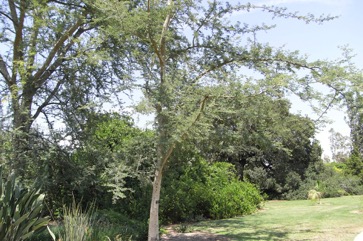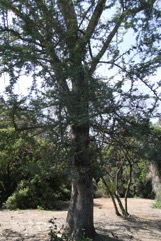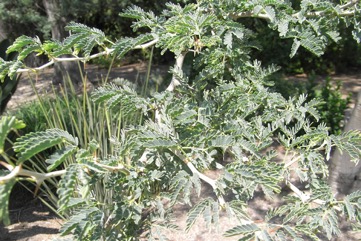White-thorn, Apple ring acacia

A tropical plant. It mostly grows on river banks and river flats and can grow on sandy soils. It can be damaged by frost. It grows in dry savannah but prefers damp sites and river banks. In southern Africa it grows between 40-1,070 m altitude. It grows in areas with an annual rainfall between 20-1,800 mm. It can grow in arid places.
Also known as:
Afrar, Ana tree, Anaboom, Apple ring acacia, Apple-ring thorn-tree, Betam-pale, Bioepi, Biongomo, Borassam-o, Borassanhe, Bubirique, Buladanelhe, Bule, Burle-danedjo, Busseu-uliba, Butchampele, Cad, Camude, Camudo, Djue, Ferida-branco, Gawo, Gozanga, Herero, Icuti, Karau, M'suango, Marrone, Msangu, Msangumsangu, Mucesi, Munga-nunsyi, Munga, Musanga, Musenga, Mutsangu, Nsangu, Omue, Pau-ferida, Po-de-ferida-branco, Sipana-brabu, Sipina, Soango, Umpumbu, Ussimpulo, Winter thorn
Synonyms
- Acacia albida Delile
- Acacia mossambicensis Bolle
- Prosopis kirkii Oliv.
Edible Portion
- Seeds, Leaves, Young pods, Gum, Caution
Where does White-thorn grow?
Found in: Africa, Algeria, Angola, Asia, Benin, Botswana, Burkina Faso, Cameroon, Cape Verde, Central Africa, Chad, Congo DR, Côte d'Ivoire, Cyprus, East Africa, Egypt, Eswatini, Ethiopia, Gambia, Ghana, Guinea, Guinée, Guinea-Bissau, India, Iran, Israel, Ivory Coast, Kenya, Lebanon, Libya, Malawi, Mali, Mauritania, Morocco, Mozambique, Namibia, Niger, Nigeria, North Africa, Oman, Pakistan, Palestine, Peru, Sao Tome and Principe, Saudi Arabia, Senegal, Somalia, South Africa, Southern Africa, South America, South Sudan, Sudan, Swaziland, Syria, Taiwan, Tanzania, Togo, Uganda, West Africa, Western Sahara, Yemen, Zambia, Zimbabwe
Notes: There are about 1,350 Acacia species. Over 1,000 occur in Australia. Also as Mimosaceae.
Status: A famine food.
Growing White-thorn, Apple ring acacia
Cultivation: Plants can be grown from seeds. The seeds are put in boiling water and soaked overnight then planted. It can be cut back and will re-grow.
Edible Uses: The seeds are boiled, then re-boiled and the skins removed then eaten in times of food scarcity. This is done to remove toxic components. The pods are sometimes eaten. The pods are used for flavouring. Caution: The seeds can contain hydrogen cyanide and would need to be cooked.
Production: Trees grow quickly. They can be 7 m high in 3 years. It develops its first fruit after 2-15 years. A large tree can yield a ton of pods.
Nutrition Info
per 100g edible portion| Edible Part | Energy (kcal) | Protein (g) | Iron (mg) | Vitamin A (ug) | Vitamin c (mg) | Zinc (mg) | % Water |
|---|---|---|---|---|---|---|---|
| Seeds (detoxify) | 344 | 24.8 | 6.8 | - | - | 2.6 | 6.5 |
| Leaves | - | - | - | - | - | - | |
| Pods - young | - | - | - | - | - | - |
White-thorn, Apple ring acacia Photos



References
Abbiw, D.K., 1990, Useful Plants of Ghana. West African uses of wild and cultivated plants. Intermediate Technology Publications and the Royal Botanic Gardens, Kew. p 46 (As Acacia albida)
Asfaw, Z. and Tadesse, M., 2001, Prospects for Sustainable Use and Development of Wild Food Plants in Ethiopia. Economic Botany, Vol. 55, No. 1, pp. 47-62 (As Acacia albida)
Ballal, M. E., et al, 2014, Ethno-botany of Natural Forests of Nuba Mountains, South Kordofan State, Sudan. Journal of Forest Poducts & Industries. 3(1):13-19
Bekele-Tesemma A., Birnie, A., & Tengnas, B., 1993, Useful Trees and Shrubs for Ethiopia. Regional Soil Conservation Unit. Technical Handbook No 5. p 38 (As Acacia albida)
Bunderson, W. T. et al, 2002, Common Agroforestry Species in Malawi. Malawi Agroforestry Extension Project, Pubication No. 46, Lilongwe. p 18
Burkill, H. M., 1985, The useful plants of west tropical Africa, Vol. 3. Kew.
Descr. Egypte, Hist. nat. 142, t. 52, fig. 3. 1813 ("1812") (As Acacia albida)
Ethiopia: Famine Food Field Guide. http://www.africa.upenn.edu/faminefood/category1.htm (As Acacia albida)
Flora of Pakistan. www.eFloras.org (As Acacia albida)
Food Composition Tables for use in Africa FAO http://www.fao.org/infoods/directory No. 850 (As Acacia albida)
Flora Zambesiaca. http://apps.kew.org/efloras (As Acacia albida)
Fowler, D. G., 2007, Zambian Plants: Their Vernacular Names and Uses. Kew. p 35
Grivetti, L. E., 1980, Agricultural development: present and potential role of edible wild plants. Part 2: Sub-Saharan Africa, Report to the Department of State Agency for International Development. p 71 (As Acacia albida)
Hepper, E.N., 1993, Illustrated Encyclopedia of Bible Plants, IVP, England. p 63, 64, (As Acacia albida)
ILDIS Legumes of the World http:www;ildis.org/Legume/Web
Jardin, C., 1970, List of Foods Used In Africa, FAO Nutrition Information Document Series No 2.p 24, 50 (As Acacia albida)
Joffe, P., 2007, Creative Gardening with Indigenous Plants. A South African Guide. Briza. p 131
Mannheimer, C. A. & Curtis. B.A. (eds), 2009, Le Roux and Muller's Field Guide to the Trees and Shrubs of Namibia. Windhoek: Macmillan Education Namibia. p 122
Martin, F.W. & Ruberte, R.M., 1979, Edible Leaves of the Tropics. Antillian College Press, Mayaguez, Puerto Rico. p 197 (As Acacia albida)
Mbuya, L.P., Msanga, H.P., Ruffo, C.K., Birnie, A & Tengnas, B., 1994, Useful Trees and Shrubs for Tanzania. Regional Soil Conservation Unit. Technical Handbook No 6. p 46 (As Acacia albida)
Menninger, E.A., 1977, Edible Nuts of the World. Horticultural Books. Florida p 88 (As Acacia albida)
Mortimer, (As Acacia albida)
Nassif, F., & Tanji, A., 2013, Gathered food plants in Morocco: The long forgotten species in Ethnobotanical Research. Life Science Leaflets 3:17-54
Palgrave, K.C., 1996, Trees of Southern Africa. Struik Publishers. p 229 (As Acacia albida)
Palmer, E and Pitman, N., 1972, Trees of Southern Africa. Vol. 2. A.A. Balkema, Cape Town p 741 (As Acacia albida)
Palmer & Pitman, 1972,
Peters, C. R., O'Brien, E. M., and Drummond, R.B., 1992, Edible Wild plants of Sub-saharan Africa. Kew. p 129
Roodt, V., 1998, Trees & Shrubs of the Okavango Delta. Medicinal Uses and Nutritional value. The Shell Field Guide Series: Part 1. Shell Botswana. p 195
Royal Botanic Gardens, Kew (1999). Survey of Economic Plants for Arid and Semi-Arid Lands (SEPASAL) database. Published on the Internet; http://www.rbgkew.org.uk/ceb/sepasal/internet [Accessed 28th April 2011]
Ruiters-Welcome, A. K., 2019, Food plants of southern Africa. Ph.D. thesis. Univ. of Johannesburg p 58
Scudder, 1971, (As Acacia albida)
van Wyk, Ben-Erik, 2019, The diversity and multiple uses of southern African legumes. Australian Systematic Botany, 2019, 32, 519–546
Venter, F & J., 2009, Making the most of Indigenous Trees. Briza. p 156
Wehmeyer, A. S, 1986, Edible Wild Plants of Southern Africa. Data on the Nutrient Contents of over 300 species (As Acacia albida)
Williamson, J., 2005, Useful Plants of Malawi. 3rd. Edition. Mdadzi Book Trust. p 9 (As Faidherbia albida)
World Checklist of Useful Plant Species 2020. Royal Botanic Gardens, Kew
www.worldagroforestrycentre.org/treedb/
www.zimbabweflora.co.zw 2011